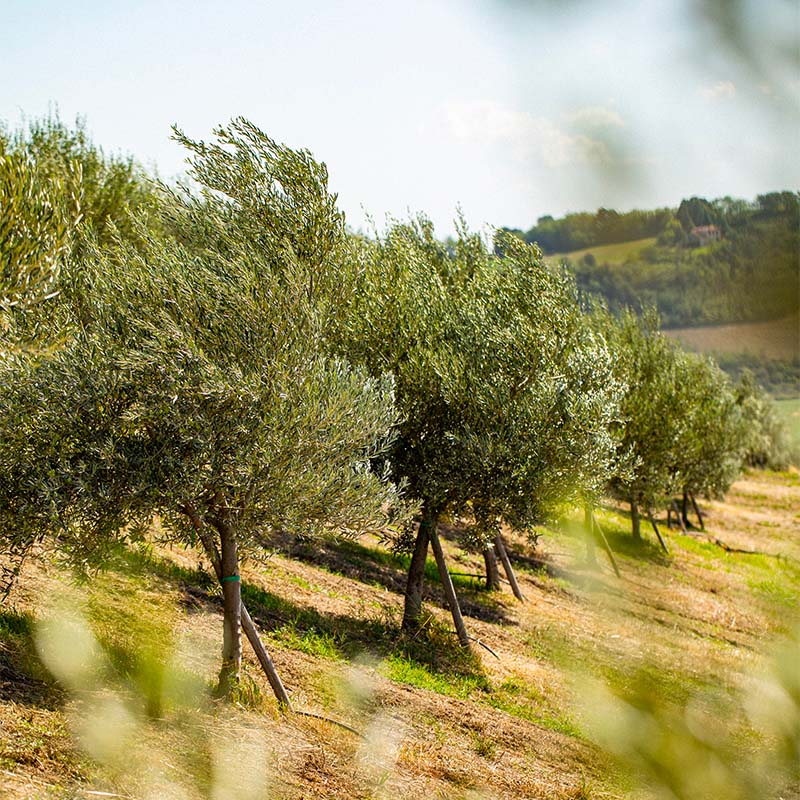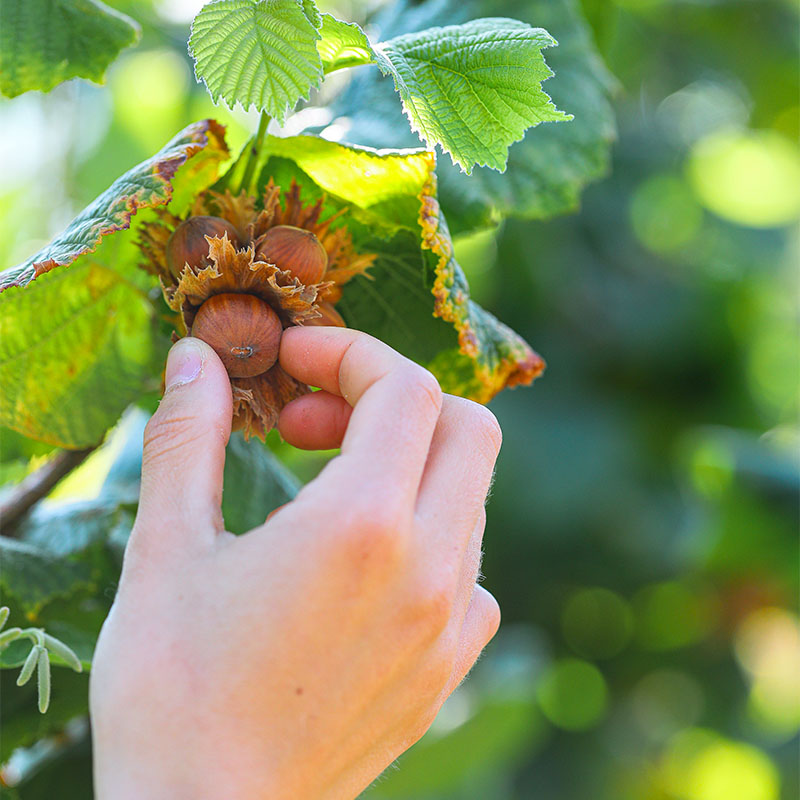OLIVE GROVE
The Agrivar olive grove was established in 2016 with the aim of reintroducing olive cultivation to the Varignana hillside, which had disappeared due to the adverse climatic conditions that affected this geographical area in the 18th century.
The entire olive-growing project is based on two main principles:
- Focusing on native cultivars;
- Intensification and mechanisation, aimed at reducing management costs and making the use of agricultural inputs more efficient and rational.
The selected varieties are primarily from Emilia Romagna, particularly “Ghiacciola,” “ Nostrana di Brisighella,” and “Correggiolo.”
These traditional varieties are typically cultivated in a polyconic vase shape. To encourage mechanisation as much as possible, the trees were planted with a row spacing of 5.5 metres between rows and 4 metres within rows, with a palmette training system to keep the plant size reduced and well-shaped.
This training method facilitates harvesting with straddle harvesters (e.g. grape harvesters) or lateral collection machines (e.g. Athena), which significantly reduce harvesting time while preserving the quality of the olives and the oil, and optimising costs.
Over the years, the olive-growing area has expanded to 265 hectares, with 12 different varieties, used to produce both single-cultivar and multi-cultivar oils.
The extra virgin olive oils currently in production are:
- Claterna Organic – Monocultivar of “Ghiacciola”
- Stiffonte – Monocultivar of “Correggiolo”
- Vargnano – Monocultivar of “Nostrana”
- Pandesco Organic – Monocultivar of “Maurino”
- LaFonte – Multicultivar: This oil is primarily made from “Leccio del Corno” olives, with other varieties blended in to create an oil with a distinct bitterness and spiciness.
- CaBianca Organic – Multicultivar: The base olives for this oil come from the “Maurino” cultivar, blended with other varieties to produce an aromatic, fresh oil with a balanced and pleasant bitterness and spiciness on the palate.
VINEYARD
The vineyard was established in 2017 with the planting of native Emilia-Romagna grape varieties, such as Sangiovese, Albana, and Pignoletto, alongside international varieties like Pinot Noir, Chardonnay, and Pinot Blanc. The winemaking project is focused on the selection and enhancement of these cultivars.
Today, the vineyard spans 50 hectares and is home to seven different varieties: Pignoletto, Albana, Chardonnay, Pinot Blanc, Pinot Noir, Sangiovese, and Malbo Gentile.
The wines produced are:
- Two Classic Method Sparkling Wines: Blanc de Noirs, Blanc de Blancs
- Two Still White Wines: Chardonnay Colli d’Imola DOC and Romagna Albana DOCG
- Two Red Wines: Sangiovese Superiore Romagna DOC and Pinot Noir Rubicone IGT
Wine production takes place entirely in the company’s winery, which was inaugurated in 2021. The facility is equipped with state-of-the-art machinery that enables the production of high-quality wines, showcasing the unique terroir of the calanchi hills. Vinification occurs in stainless steel and cement tanks.
Lastly, in the elegant and welcoming atmosphere of the tasting room, visitors can enjoy tastings of wines, extra virgin olive oils, and other products from the estate and the surrounding area.
HAZELNUT AND ALMOND GROVES
Another rapidly growing sector of the farm is the nut production, particularly almonds and hazelnuts, cultivated over an area of approximately 7 hectares.
The main variety grown is the Gentile delle Langhe, which is primarily used for tastings, at the Resort and Agriturismo’s breakfast service, as a zero-kilometre aperitif snack, and for the preparation of recipes and desserts served in our restaurants.
Together with the hazelnuts, the almonds help expand the range of zero-kilometre products offered by our farm.
POMEGRANATES AND FRUIT GROVES
Completing the range of the farm’s cultivations are the native fruit crops and pomegranate orchards.
These crops have developed alongside the entire agricultural project and now cover an area of approximately 30 hectares.
What sets the fruit from these orchards apart is its versatile use. Peaches, apricots, plums, pears, apples, and figs are consumed fresh, as well as transformed into juices and spreadable fruit, which are offered to guests during breakfast, paired with tastings of extra virgin olive oil and wine, and sold at the farm’s retail outlets, both within the agritourism and at various Resort outlets.
SAFFRON
Among the farm’s flagship crops is saffron (*Crocus sativus*), grown over an area of 2,000 square meters. We use this “red gold” in the kitchens of the Agriturismo and Resort restaurants at Palazzo di Varignana. It is also sold in an elegant gift box.
In September, after the summer heat has passed and the rains begin to cool the air and moisten the soil, the saffron bulb ends its dormancy and starts to sprout. The shoot pushes its way through the soil to the surface, where it will open, first revealing the leaves and then, later, the flowers.
Each saffron flower has six tepals of a deep violet colour (in botanical terms, the correct word for what is commonly referred to as petals is “tepals”). Inside the flower are the stigmas—three red threads that are the true product of the cultivation. Once dried, these threads become the precious spice.
In fact, the saffron flower is completely sterile; the *Crocus sativus* plant can no longer produce fruit or seeds and is propagated exclusively by the division of bulbs.










